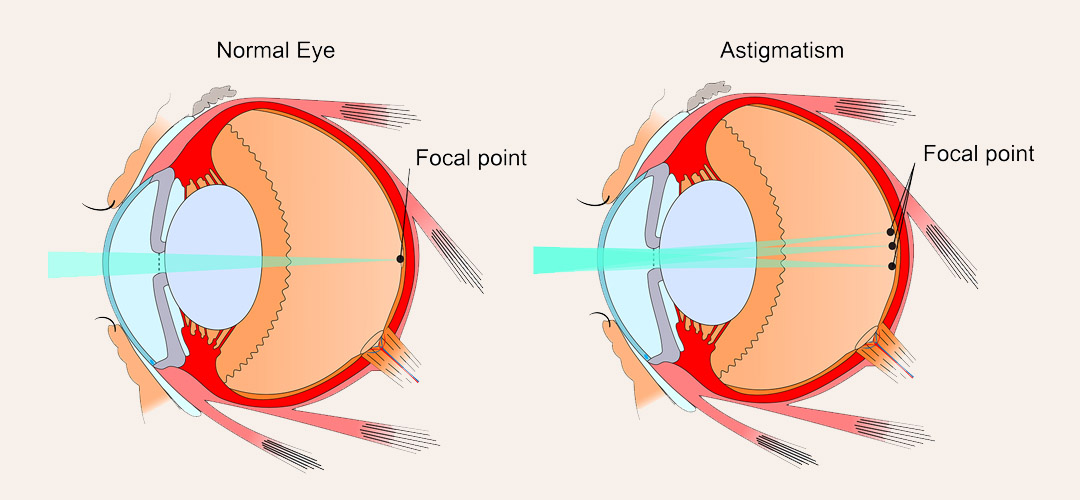DEPARTMENT
ASTIGMATISM
Astigmatism – what is it?
Astigmatism is one of the most common causes of low visual acuity. This violation is the inability of the visual system to focus on the objects under consideration. Often, astigmatism is combined with other ophthalmic diseases – myopia and hyperopia.

Causes
Translated from Latin, the term “astigmatism” means “no point of focus”. Most often this functional impairment is caused organically: the focus is broken due to an irregular lens shape or uneven cornea. These eye structures normally have a regular spherical shape and a flat surface. Organic anomalies with astigmatism create conditions for inadequate refraction of the rays. The unevenness of the curvature of different parts of the surface leads to the formation of a distorted image. Only a part of the rays passing through the optical media focuses on the retina, the others – in front of it or behind it. Accordingly, the object is seen as only partly sharp, and sometimes very vague.
Distinguish between corneal and lens astigmatism. Distortion of the shape of the cornea affects the visual acuity more strongly, because it provides the greatest refraction.
The degree of astigmatism is measured in diopters. The indicator reflects the difference in the refractive power of the strongest and weakest meridians of the cornea. Essential is also the direction of these meridians, where the axis of astigmatism is expressed in degrees.
Degrees of astigmatism
There are three degrees of astigmatism:
- astigmatism of a weak degree – up to 3 D;
- astigmatism of medium degree – from 3 to 6 D;
- astigmatism of a high degree – above 6 D.
Types of astigmatism
On an etiology distinguish astigmatism congenital and acquired (secondary).Congenital astigmatism up to 0.5 diopters is inherent in practically all infants during the newborn period. This functional disorder is not considered a pathology, because it is associated with underdevelopment of the cornea and excessive steepness of its surface. The astigmatism of the newborn does not affect the visual acuity in the future, does not require intervention and passes in the first years of life.
Congenital astigmatism more than 1.0 D is already considered a violation, requires observation and spectacle correction.Acquired astigmatism develops as a consequence of adverse effects on the visual system. The most common causes of scar formation, unevenness and corneal shape disorders are trauma and damage to the eye area, surgical intervention in the treatment of other ophthalmic diseases.
Correction of astigmatism
Modern ophthalmology offers three methods of vision correction with astigmatism:
- glasses;
- contact lenses;
- excimer laser correction of the cornea.
Ophthalmic correction
When astigmatism is usually written out special “difficult” glasses. Cylindrical lenses of such a device provide an unequal force of correction at different sites. Combined correction tries to maximize the individual needs of each patient. Nevertheless, many patients complain of unpleasant side effects of such correction: visual discomfort, pain in the eyes, headaches.
The appointment of “complex” glasses requires careful diagnosis, since in the recipe for the optical device should be indicated not only dioptries, but also data on the force and direction of the axis of the correcting cylinder. Quite common is the situation where a person with astigmatism has to change glasses several times to find the best ones that do not cause discomfort and fatigue.
Contact lenses for astigmatism
Until recently, for patients with astigmatism, only correction with rigid contact lenses was possible. We can not say that they are convenient to use, and physiologically hard lenses are not entirely compatible with the surface of the eye.
Modern ophthalmology offers special “toric” lenses for patients with astigmatism. These are soft contact lenses, which allow to provide the necessary degree of correction on different meridians of the cornea.
It is worth noting that any optical correction is just symptomatic help. Lenses and glasses do not solve the problem, but only allow to maintain an acceptable level of visual acuity. Cardinal treatment is possible only through surgery. If the choice of the patient remains for wearing lenses or glasses, remember the need for regular examinations with an ophthalmologist. Visual acuity may change over time. Untimely replacement of optics can negatively affect and aggravate the disease.
Excimer laser correction of astigmatism
With astigmatism with indices up to ± 3.0 D, high excimer-laser correction shows high efficiency. The LASIK method is most widely used. This procedure is not even easy to call an “operation”, since it lasts only 10-15 minutes and is maintained by drip local anesthesia. Most of the time is spent on preparatory manipulations, and the laser exposure itself lasts no more than 40 seconds. Treatment is performed on an outpatient basis in the “one day” regime, is safe and does not impose serious restrictions on the patient during rehabilitation.
The LASIK methodology includes several stages. At the beginning of the operation, using a special instrument (microkeratome), a flap is detached on the surface of the cornea. The thickness of this layer is only 130-150 microns. Such training provides access to deeper layers. Using a laser, evaporation takes place in the thickness of the cornea. The separated flap is then returned to the site, closing the area of exposure. It is fixed by the natural collagen of the eye. The procedure does not require suturing, the formation of scarring on the surface and other complications is excluded. Such treatment of astigmatism provides a stable result. Vision improves within the first two hours after surgery, and the maximum recovery occurs within a week. Rehabilitation after LASIK procedure is minimal, which allows the patient not to “fall out” of the labor process.
What is dangerous is astigmatism
Astigmatism in itself does not improve the quality of life. The fuzziness of visual images can lead to headaches, rubbing and fatigue of the eyes, lacrimation. In addition, the constant violation of focusing causes a need to compensate for this pathology, which can provoke the development of strabismus and a rapid decrease in visual acuity (amblyopia). Having the diagnosis of “astigmatism”, do not neglect regular visits to the ophthalmologist, so as not to miss serious complications.

Another way of treatment is a LASIC.
It does a excellent job. Some lasers do a better job with different types of astigmatism.
The most common symptoms of astigmatism are:
- Blurred vision
- Fatigue
- Headaches
- Eye pain
The causes of astigmatism.
Since astigmatism is a distortion of the cornea, it is difficult to pinpoint its exact cause. Over time, the cornea of the eye can lose its natural roundness. In addition, poor posture, and frequent tilting of the head can lead to astigmatism and problems with perception.

There is a team of professional doctors whose specialized in different areas of ophthalmology, and have experience in Russia and around the world!
More than 12 years experience, 2 clinics with modern medical appliance, international acknowledgement, all of this makes ophthalmic clinic “UZLLOVA” – as an leader in Albania on ophthalmology.
BOOK ONLINE
Address
Qemal Stafa Str, Apt 31, 3-rd C Floor
Near the General Prosecutor’s Office
klinika.uzllova@yahoo.com
info@eye.al
Phone
0682074039
04 22 52 306


